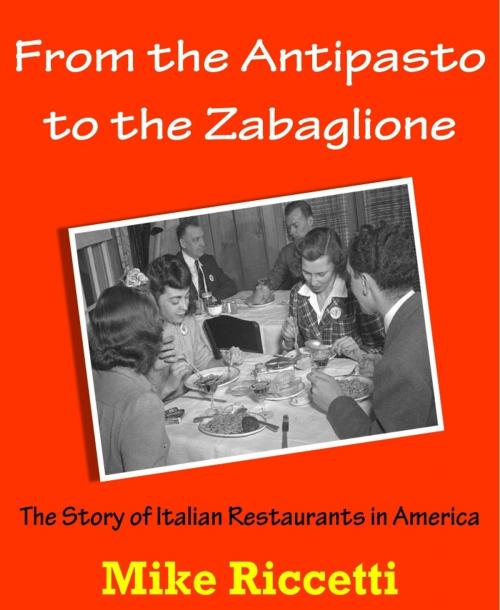From the Antipasto to the Zabaglione: The Story of Italian Restaurants in America
Nonfiction, Food & Drink, International, European, Italian, History, Americas| Author: | Mike Riccetti | ISBN: | 9780971404076 |
| Publisher: | Mike Riccetti | Publication: | September 2, 2011 |
| Imprint: | Smashwords Edition | Language: | English |
| Author: | Mike Riccetti |
| ISBN: | 9780971404076 |
| Publisher: | Mike Riccetti |
| Publication: | September 2, 2011 |
| Imprint: | Smashwords Edition |
| Language: | English |
From the Antipasto to the Zabaglione tells the story of Italian restaurants in America. There is certainly more to Italian food in this country than what is found in its Italian-themed restaurants. But, it is an appealing tale in its own right, and one that has not yet been fully told. This fairly concise tome follows the food of the Italian immigrants from port cities, Bohemian enclaves and the early cheap, table d’hôte eateries through the appearance of spaghetti and meatballs and the development of a recognizable Italian-American cooking, with which America fell in love, to the introduction of fine-dining then alta cucina, sleek trattorias, regionally inspired spots and beyond. It is an enjoyable saga.
Italian restaurants have been more influential on the dining habits of Americans than most realize. Italian restaurants have introduced foods and dishes, and codified Italian preparations for diners and home cooks. The osso buco, veal Parmesan, saltimbocca, Caesar salad, tiramisu and many others you might have prepared at home are not the result of any Italian home-cooking tradition but are dishes that first appeared in restaurants and made the transition to the home kitchen. The restaurants at the cutting-edge – the focus a fair portion of this story – have introduced dishes and products that are imitated and translated by the other establishments. It might take a decade for their creations that have struck a chord with the public to filter all the way down, maybe less in this hyper-connected world, but the famed, truly innovative restaurants usually have an influence well beyond the customers they have served. The direction of Italian food in this country has been set largely by these places.
Mamma Leone, Gennaro Lombardi, Romeo Saltalamacchia, Mauro Vincenti, Piero Selvaggio, Tony Many, Pino Luongo, Lidia Bastianich and Mario Batali are just a few of the featured players, a list which also includes some distinctly non-Italian names like Wolfgang Puck and Michael White. The widely researched, if succinct, From the Antipasto to the Zabaglione tells the tale of this enjoyable subject in properly engaging fashion.
From the Antipasto to the Zabaglione tells the story of Italian restaurants in America. There is certainly more to Italian food in this country than what is found in its Italian-themed restaurants. But, it is an appealing tale in its own right, and one that has not yet been fully told. This fairly concise tome follows the food of the Italian immigrants from port cities, Bohemian enclaves and the early cheap, table d’hôte eateries through the appearance of spaghetti and meatballs and the development of a recognizable Italian-American cooking, with which America fell in love, to the introduction of fine-dining then alta cucina, sleek trattorias, regionally inspired spots and beyond. It is an enjoyable saga.
Italian restaurants have been more influential on the dining habits of Americans than most realize. Italian restaurants have introduced foods and dishes, and codified Italian preparations for diners and home cooks. The osso buco, veal Parmesan, saltimbocca, Caesar salad, tiramisu and many others you might have prepared at home are not the result of any Italian home-cooking tradition but are dishes that first appeared in restaurants and made the transition to the home kitchen. The restaurants at the cutting-edge – the focus a fair portion of this story – have introduced dishes and products that are imitated and translated by the other establishments. It might take a decade for their creations that have struck a chord with the public to filter all the way down, maybe less in this hyper-connected world, but the famed, truly innovative restaurants usually have an influence well beyond the customers they have served. The direction of Italian food in this country has been set largely by these places.
Mamma Leone, Gennaro Lombardi, Romeo Saltalamacchia, Mauro Vincenti, Piero Selvaggio, Tony Many, Pino Luongo, Lidia Bastianich and Mario Batali are just a few of the featured players, a list which also includes some distinctly non-Italian names like Wolfgang Puck and Michael White. The widely researched, if succinct, From the Antipasto to the Zabaglione tells the tale of this enjoyable subject in properly engaging fashion.















